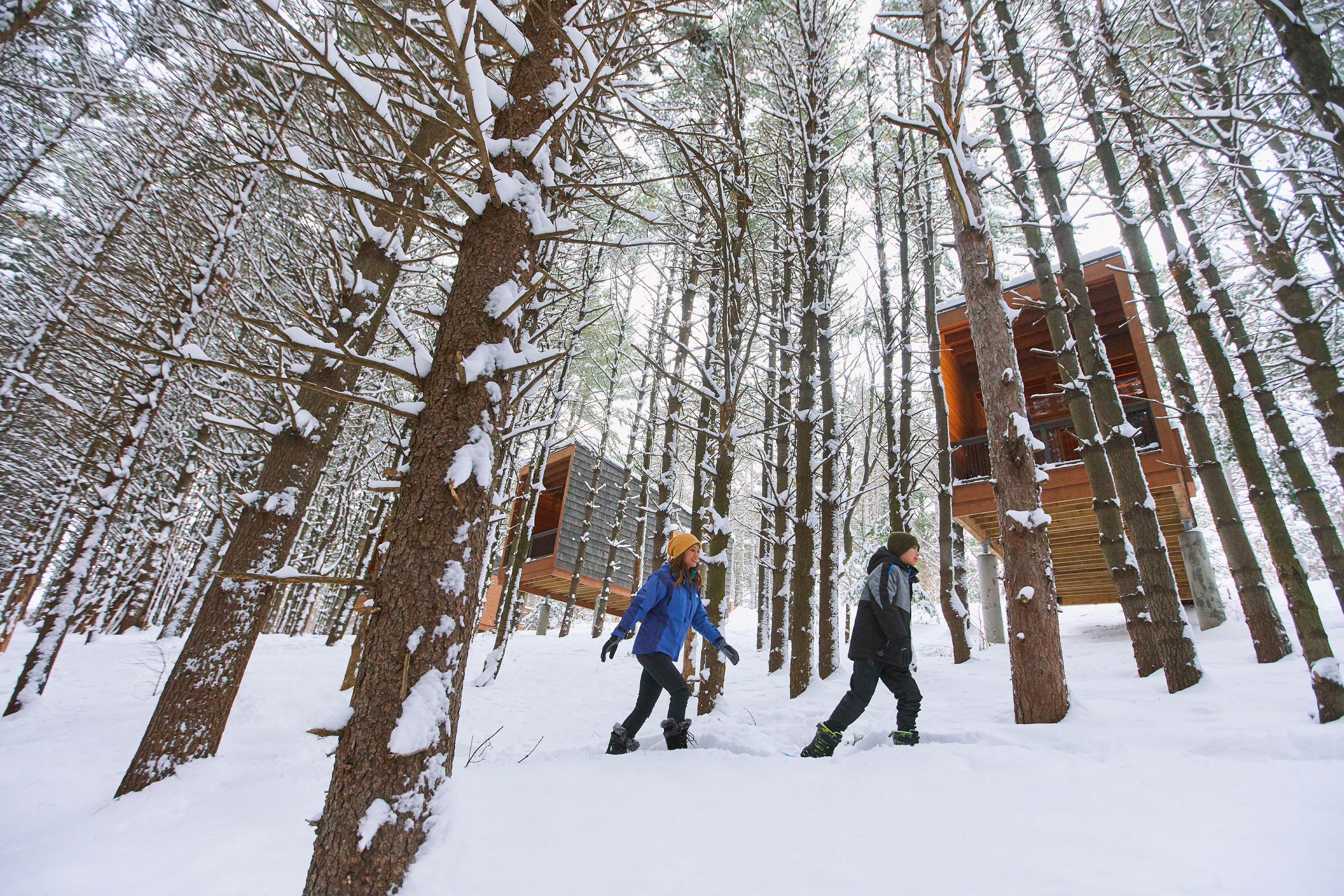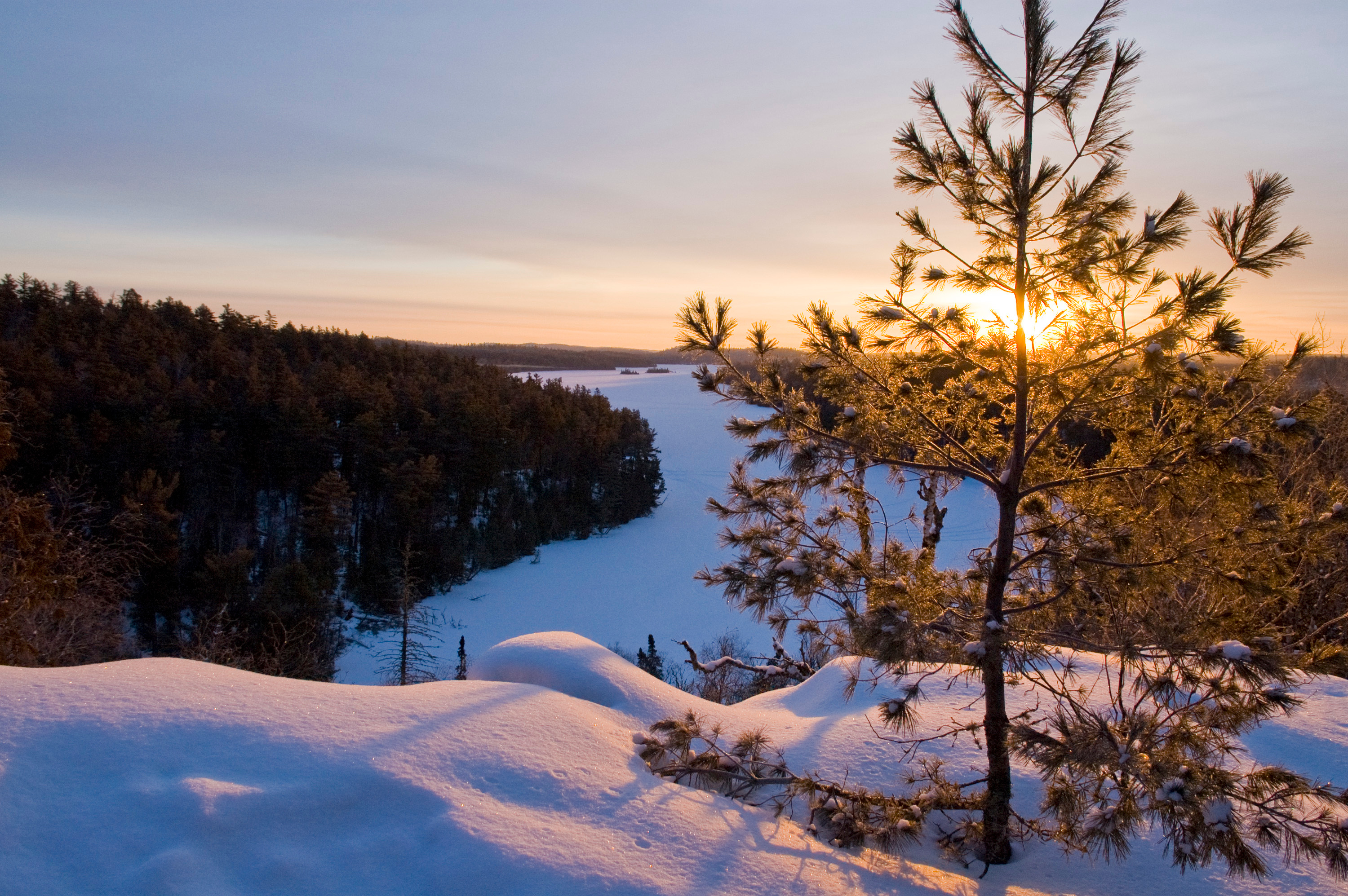
Where to Snowshoe in Minnesota
Where to Snowshoe in Minnesota
By James Riemermann
For a memorable and fun winter activity nearly anyone can do, strap on a pair of snowshoes and venture deep into the snow-covered Minnesota wilderness.

Snowshoeing Whitetail Woods, Farmington / Paul Vincent
Snowshoes are more than just another way to get around in the snow. They can take you deeper into the wilderness than you’ve probably ever been. They’re easy to learn to use (just strap them onto your shoes and start walking), relatively inexpensive, and better than skis for getting into unexplored areas. And there’s simply no better way to spot wildlife than padding quietly into deep, snowy woods where the landscape is sparse, the trees are bare and the snow cover is unbroken but for the occasional animal tracks.
“You can snowshoe almost anywhere,” says Barbara Young of Boundary Country Trekking, a wilderness outfitter and lodging business along the Gunflint Trail near Grand Marais. “You don’t need a trail. If you’re the first one in, you can head into the woods and break your own trail. You won’t get lost because you can just turn around and follow your own tracks out.”
With that in mind, here are some of our favorite spots to snowshoe....

Snowshoeing on Round Lake, Gunflint Trail
GUNFLINT TRAIL
Some of the finest wilderness snowshoeing in the state — or for that matter, the world — can be had along the Gunflint Trail, a two-lane highway that serves as the eastern entry to the Boundary Waters Canoe Area Wilderness, a million-acre network of pine forests and snow-covered lakes along the Canadian border.
Boundary Country Trekking is just one of many Gunflint Trail resorts and adventure trip outfitters that cater to snowshoers, cross-country skiers and dog sledders. Most resorts in the area rent snowshoes, and many, including Bearskin Lodge, Gunflint Lodge and Gunflint Pines, have nearby access to trails groomed for snowshoeing — just flattened a bit to make trekking easier until you’re ready to blaze your own trail.

The winter landscape at West Bearskin Lake on the Gunflint Trail
“You can also snowshoe on many of the lakes up here,” says Young, “but make sure you ask resort owners in case there are any unsafe areas for snowshoeing.” Most of the ice is very thick and safe to walk on in the middle of winter, but some lakes have creeks and other inlets where the ice can be slushy or too thin.
Snowshoers must keep off trails groomed for cross-country skis or snowmobiles, and multi-use trails open to snowmobiles are risky, since snowmobilers can’t see you when they come around curves. But that leaves a lot of designated trails and vast expanses of land, public and otherwise, that are perfect for snowshoeing.

Take your pups on a winter hike at Tettegouche State Park / Rick Scheradella
STATE PARKS
Statewide, you can snowshoe anywhere in Minnesota’s 74 state parks and recreation areas, on- or off-trail, except on trails specifically groomed for another activity. Thirty state parks rent snowshoes for a mere $6 a day, and a number have groomed snowshoe trails, including Grand Portage State Park in the northeast, Itasca State Park in the northwest, Maplewood, Glendalough and Sibley state parks in central Minnesota, Fort Snelling State Park in St. Paul, and Flandrau State Park in southern Minnesota.
In addition, the Department of Natural Resources manages more than 160 scientific and natural areas, eight of which are particularly recommended for snowshoeing.

Voyageurs National Park in the dead of winter / Abdiel Nieves
NATIONAL FORESTS
Other outstanding snowshoeing opportunities can be found in both Chippewa and Superior national forests, with about 4.5 million acres of heavily wooded public land between them. As with the state parks, snowshoeing is permitted anywhere that is not specifically groomed for other activities.
Voyageurs National Park on the Canadian border has six designated snowshoe trails in addition to vast off-trail areas open to snowshoeing. In fact, loaner snowshoes are often available free of charge through the park’s Rainy Lake Visitor Center.

Gear up for a Minnesota snowshoeing adventure through the woods / @hikingthenorth
MINNEAPOLIS-ST. PAUL
There’s a wealth of snowshoeing opportunities in the city and regional parks of Minneapolis-St. Paul, as well. A dozen parks within the Three Rivers Park District, mostly in the western suburbs of Minneapolis, have designated snowshoe trails and several schedule snowshoe-centered events over the winter, including guided hikes for beginners, full moon hikes, and guided family hikes with hot cocoa served afterward.
The portion of Minnehaha Creek in Minneapolis is also surrounded by parklands, offering excellent snowshoeing along the creek to where it meets the Mississippi River at Minnehaha Park.
The Minnesota Valley National Wildlife Refuge in Bloomington offers great snowshoeing into areas that are inaccessible most of the year, and lends snowshoes free of charge out of its Visitor and Education Center. In St. Paul, much of the best snowshoeing can be found along the Mississippi River at Hidden Falls/Crosby Farm Regional Park, the Bruce Vento Nature Sanctuary and Battle Creek Regional Park.
SOUTHERN MINNESOTA
In addition to the aforementioned Flandrau State Park in New Ulm, southern Minnesota has great snowshoeing at Frontenac State Park — nearly 5 miles of designated trails along and near the great widening of the Mississippi known as Lake Pepin — and Whitewater State Park. All three parks also rent snowshoes.
Find more things to do in Minnesota this winter.


